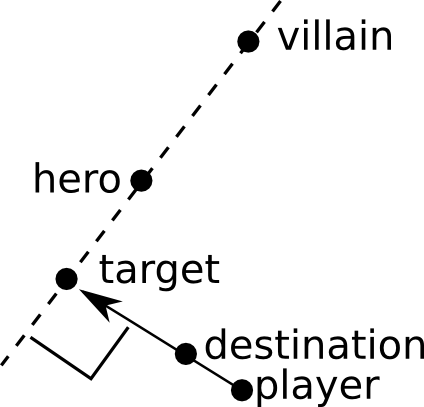This is an explanation of a graphical demo I call “Heroes and Villains”. I wrote the first version in my first year of university and it was one of the first demos on this site. I revisited the code several years later when I entered the demo in JS1K competition, and re-implemented it in less than 1 kilobyte.
Etymology
The demo is named after a “getting to know you” game. Take a room full of people and tell each of them to choose one person to be their “hero”, and choose a second person to be their “villain”, keeping the identity of both a secret. Then tell each person to move such that their hero is between themselves, and their villain. As each person moves into position, they force other people to keep moving, as the position of each person affects the position of people who have chosen them as heroes or villains. Played indoors in groups of around 15, people tend to stand in lines moving sideways or radially about the centre of the room, and tend to also move outwards getting as close to walls as possible.
Naturally, the question arises: “Will the system ever reach a stable state, where everyone’s hero is between themselves and their villain?” This demo started out as an attempt to simulate the game with a large number of players in a large space over a long period.
How it works
Initialization

|
Initially, each player is randomly assigned a position, and a pair of other players - one its hero, and the other its villain. When a player A is assigned as the hero of some other player B, B gets assigned as the villain of A. The likewise is true when a player is assigned as a villain. See the diagram to the right for a graphical explanation.
This reflexive property is not part of the original game, and several hero/villain assignment policies were experimented with, and this one seemed the most interesting to watch.
Simulation
The simulation is broken into discrete ticks. That is, there is an operation that is repeated infinitely at some frequency. This operation consists of calculating the next position of each player based on their current positions, updating the position of each player, and drawing each player to the display.
The rules of the simulation used in the calculation of each player’s position are as follows.
- If a player’s hero is between themselves and their villain, the player stays where it is.
- Otherwise, a player moves towards the nearest point that would put its hero between itself and its villain.
In order to calculate the point a player will move to, there are two scenarios depending on the relative positions of the player, their hero and their villain. Scenario 1 is assumed, and the point that would be used is checked to see if it places the hero between the player and its villain. If this property is not met, scenario 2 is used instead. Once the target is found, the player moves some small distance towards it.






